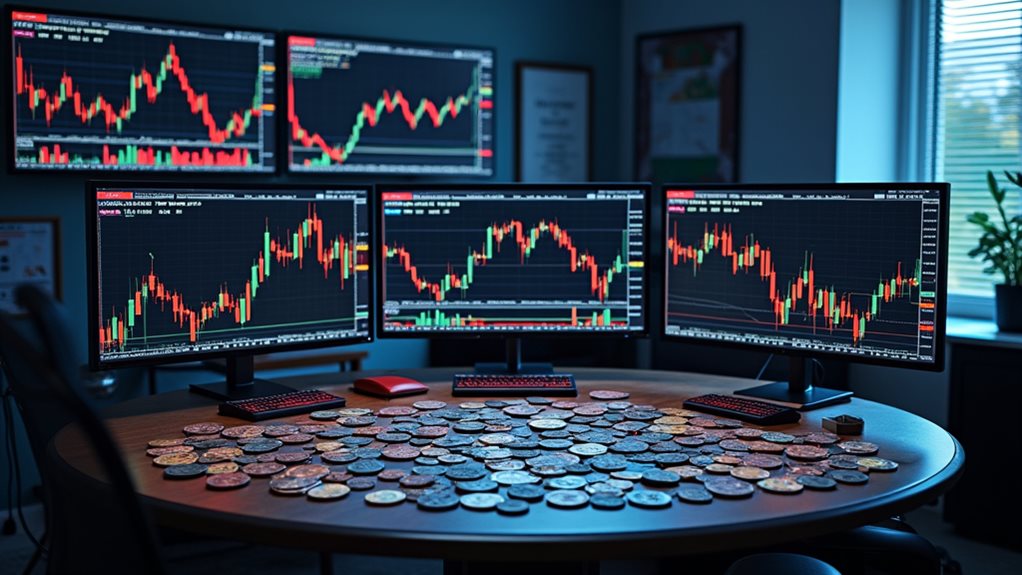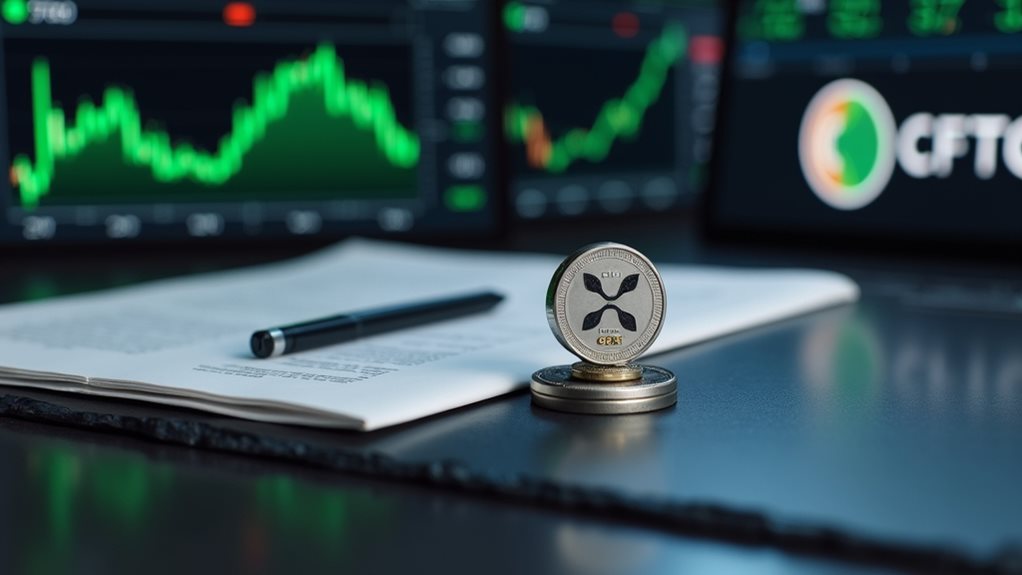Successful crypto trading demands disciplined risk management. You'll need to implement stop losses (5-10% below entry), maintain a 1:2 risk-reward ratio, and size positions at just 1-2% of your capital per trade. Don't put all your crypto eggs in one basket—diversification saves wallets when markets tank. Emotional trading? That's how $2.2 billion got liquidated in 2024. Hardware wallets and two-factor authentication aren't optional in this wild west. The smartest traders know emotions are the biggest threat to their portfolios.
Key Principles of Crypto Risk Management

Volatility. It's the one constant in crypto markets. You'll get whiplash watching those price charts—up 20%, down 15%, sometimes in a single day. Crazy, right? This roller coaster demands serious risk assessment before you jump in.
Start by honestly evaluating what you can afford to lose. No sugarcoating here. The crypto market doesn't care about your financial goals. Authorities now recommend implementing robust data frameworks proportional to the complexity of your trading activities.
The market won't shed tears over your empty wallet. Only invest what you can watch disappear.
Regulatory compliance isn't just boring paperwork. It's your safety net in a largely unregulated space. Rules change fast. One day you're trading freely, the next your exchange is banned in your country. Securing your assets with hardware wallets has become essential as crypto theft reached $2.2 billion in 2024.
Remember: diversification isn't just advice—it's survival. Spread those bets across different assets. One coin tanks? You're not completely wrecked. Utilizing stop loss orders can automatically limit your losses and protect your capital when markets move against your position.
Essential Stop Loss and Take Profit Strategies

When markets swing wildly, you need guardrails. That's where stop loss strategies come in—they're not optional in crypto. Set them 5-10% below your entry price and sleep better at night. Seriously.
Your stop loss should reflect market volatility. Below moving averages? Sure. Under support levels? Even better. Just put them somewhere, for crying out loud. Like in bear market conditions, selling everything is rarely the optimal strategy.
Take profit techniques are equally vital. Lock in gains before the market yanks them back. Aim for a 1:2 risk-reward ratio minimum. Place orders just under resistance levels where prices typically reverse. Trailing take-profit orders automatically adjust your profit target as prices move in your favor, letting you maximize gains while still protecting your position.
Combine both orders for proper protection. Automated trading beats emotional decisions every time. Markets don't care about your feelings—they'll crush them anyway. Effective risk management helps you seize opportunities within acceptable parameters while protecting your capital from devastating losses.
Review and adjust regularly. No exceptions.
Diversification: The Balance Between Safety and Growth

Despite what crypto influencers might tell you, putting all your money into a single moonshot token is a recipe for disaster.
Smart traders know better. They spread investments across different coins, sectors, and even regions.
The diversification benefits are clear—less exposure to single-asset crashes and better chances at catching winners across various market segments. DeFi today, gaming tokens tomorrow. Who knows? Some investors are turning to stablecoin options as a way to reduce portfolio volatility while maintaining crypto exposure.
But let's be real. Diversification challenges exist too. More coins mean more fees. More complexity. And sometimes, less explosive gains. Bitcoin dominates so heavily that many alts follow its lead anyway. Regularly monitoring and rebalancing your portfolio is essential to maintain effective diversification as market conditions evolve.
Your best bet? Balance high-risk plays with stable assets. Mix sectors. Don't overdo it—tracking 50 different tokens will drive you insane. A well diversified portfolio typically includes established cryptocurrencies like Bitcoin and Ethereum alongside smaller assets with growth potential.
Position Sizing Techniques for Market Volatility Protection

Three critical numbers define successful crypto traders: entry point, exit point, and position size. Forget the last one and watch your portfolio implode. Seriously.
In crypto's wild west, controlling risk exposure isn't optional—it's survival. Fixed percentage risk (1-2% per trade) keeps you in the game long-term. Simple math, really. Implementing dollar-cost averaging helps smooth out market volatility impacts on your portfolio.
Volatility adjustments using ATR indicators help you respond to market conditions rather than becoming their victim. A balanced risk-reward ratio can help you remain profitable even with a lower win rate.
Stop-loss orders aren't for the weak—they're for the smart. Set them. Use them. No exceptions. The Kelly Criterion offers a mathematical approach to optimizing your position size based on your historical win probability.
Your position sizes should breathe with the market. Small during chaos, larger during stability. Ignoring this? Might as well hand your money directly to smarter traders.
Remember: Overleveraging kills accounts faster than bad entry points ever could.
Psychological Aspects of Risk Management in Cryptocurrency Trading

Technical position sizing won't save you if your brain betrays you at every market swing.
That's the harsh reality of crypto trading. Your emotional resilience matters more than you think.
Ever bought because everyone else was? Classic herd behavior.
Following the herd in crypto isn't strategy—it's surrender to psychological triggers that historically lead to financial regret.
Or maybe you've held onto a plummeting token because "it'll bounce back."
Congrats—you've met confirmation bias, your portfolio's worst enemy.
The recent $2.2 billion liquidation showed how emotional trading can devastate portfolios overnight.
FOMO drives terrible decisions. Period.
So does overconfidence. You're not a genius when your trades succeed—sometimes you're just lucky.
Trading plans aren't just spreadsheets—they're shields against your own cognitive biases.
When market chaos hits, emotions flood in. Fear. Greed. Panic.
The market doesn't care about your feelings.
But they'll certainly impact your returns.
Using stop-loss orders can prevent emotional interference when markets move against your position.
Establishing a clear risk/reward ratio before entering trades helps maintain rational decision-making even when emotions run high.
Advanced Tools for Monitoring and Mitigating Crypto Risks

While your emotional discipline forms the foundation, sophisticated risk management tools provide the fortress walls for your trading operation.
Today's crypto landscape demands more than gut feelings—it requires advanced analytics and predictive modeling capabilities.
Most traders don't realize how exposed they are. Tools like Merkle Science's behavioral rule engine can flag suspicious activities before they hit blacklists. Serious stuff.
Two-factor authentication remains a fundamental defense layer that no serious crypto trader should ignore.
Here's what you need on your radar:
- Cryptographic assessment platforms like ISARA Advance to identify vulnerable points in your security infrastructure
- Blockchain intelligence solutions from TRM Labs for cross-chain transaction monitoring
- Predictive transaction systems that analyze patterns and alert you to potential risks
Risk management isn't sexy, but neither is losing your shirt in a preventable security breach. The Compass platform helps prevent fraud while ensuring compliance with AML, KYC, and CFT regulations that govern responsible trading.
Implementing solutions that prioritize transparency in transactions is crucial for maintaining credibility in the volatile crypto market.
Building a Sustainable Risk Management Framework for Long-Term Success

Beyond flashy tools and quick fixes, building a sustainable risk management framework separates the crypto survivors from the casualties. You need sustainable strategies that'll weather both bulls and bears.
Start with diversification—it's not sexy, but it works. Your portfolio shouldn't crumble when one coin tanks. Implementing stop loss orders is essential to automatically protect your investments when prices drop unexpectedly.
Brutal truth? Most traders fail because their risk frameworks are emotional reactions, not systems.
Regulated platforms aren't just safer; they're smarter long-term plays. Two-factor authentication isn't optional anymore, folks. With digital asset reporting becoming stricter under new IRS requirements, choosing compliant platforms is crucial.
Review your strategy regularly. Markets change. You should too.
And here's something nobody tells you: mindfulness practices reduce panic selling. Seriously. Your biggest enemy isn't the market—it's your lizard brain during volatility. Master that, and you've got a fighting chance.
Trading with a favorable risk-to-reward ratio ensures you're making informed decisions that balance potential profits against your exposure.
Frequently Asked Questions
How Do Tax Regulations Affect Crypto Risk Management Strategies?
Tax regulations shape your crypto risk management through tax implications and reporting requirements. You'll need to track transactions carefully, adjust strategies for tax optimization, and guarantee regulatory compliance to minimize financial and legal risks.
Can Insurance Products Protect Crypto Assets From Security Breaches?
Yes, crypto insurance can protect your assets from security breaches, but coverage is limited. You'll find more protection for cold storage than hot wallets, and institutional policies offer better asset protection than consumer options.
How Do Stablecoins Fit Into a Risk Management Framework?
You'll find stablecoins serve as volatility hedges in your risk framework. They're useful for liquidity management during market turbulence. However, you must monitor their own stability risks through regular reserve audits and issuer assessment.
Are Hardware Wallets Necessary for Small Portfolio Investors?
For small portfolios, hardware wallets aren't strictly necessary but provide superior security. You'll benefit from offline hardware security that software wallet types can't match, especially as your investments grow over time.
How Does Staking Impact Overall Portfolio Risk Assessment?
Staking rewards can lower your overall portfolio risk by providing steady income streams and enhanced portfolio diversification. You'll benefit from reduced correlation with traditional assets, but must balance lock-up periods against liquidity needs.









